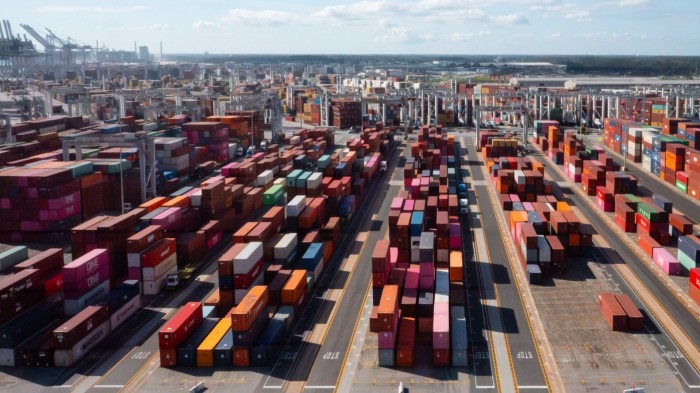US firms fine-tune global expansion ambitions

Roula Khalaf, Editor of the FT, selects her favourite stories in this weekly newsletter.
Over the past decade, many US law firms have shunned their American roots, marketing themselves as “global” networks to appear borderless to their clients.
But, with many observers predicting a slowdown, stalling or even partial unravelling of globalisation, the imperative of cross-border expansion in the legal world is also under review.
“The time of firms planting flags on the map is over,” says Tony Williams, principal at Jomati Consultants and managing partner of leading UK law firm Clifford Chance in the late 1990s. “People will look at markets in quite a hard-nosed way and say: ‘Is this relevant for us for the long term? Are we getting real traction from the clients?’”
Profound disruptions — caused by Covid-19, US-China trade tensions, and Russia’s invasion of Ukraine — have all forced governments and businesses to review their interdependency and the reliability of their supply chains.
“Friend-shoring” — countries setting up supply chains with more trusted nations — has grown up as an alternative to reliance on locations such as China and Russia. Meanwhile, strategic sectors, including military equipment and semiconductors, have seen an active reshoring effort from governments, according to Barret Kupelian, chief economist at PwC UK, the professional services firm.
“The innocence that characterised trading relations at the end of the 20th century is gone,” says Kupelian. “At the end of 2019, the firm [PwC] stated that ‘slowbalisation’ is the new globalisation, and we have been broadly on the right track.”
The inherently local nature of law has led to different approaches towards internationalisation by US law firms over the years. For some, such as White & Case, global offices have long been part of the strategy, with outposts in places like Paris dating back to the 1920s. Others, such as Cravath, Swaine & Moore, have preferred a “best friend” approach, working with a network of top native firms in each jurisdiction and benefiting from the referrals.
But, as geopolitical events push a shift in trading between countries, the impetus to create global networks that match the geographic footprints of leading clients has led many US firms to reconsider their international approach.
Cravath launched a London-based English law offering this year, despite its longstanding “best friend” relationship with Slaughter and May.
And, with locations such as Saudi Arabia opening up to western law firms, many have applied for licences there. In October, Kirkland & Ellis said it was opening an office in Saudi Arabia after new rules allowed firms to operate solo, rather than with a local affiliate.
Gibson Dunn opened an office in Riyadh in November, and King & Spalding has obtained a licence to operate as a standalone firm there. Meanwhile, Ropes & Gray and Quinn Emanuel Urquhart & Sullivan are opening in Singapore.
“We’ve certainly seen an increased level of protectionism, an increased level of onshoring and, in terms of how it impacts our world, I would say that you’re seeing clients be a lot more careful about cross-border deals,” says
Neill Jakobe, a member of Ropes & Gray’s governing management committee. “That . . . from a legal perspective, creates more complexity and more work for us.”
US law firms have also been growing domestically, with a spate of new offices.
Kirkland & Ellis, Sidley Austin and Winston & Strawn launched offices in Miami last year after several big tech companies expanded there, lured by tax benefits. Cravath opened an office in Washington DC, and Cleary Gottlieb launched a base in San Francisco in 2021.
“In some ways, what’s happening is a shift in terms of what the priority markets are, or might be, going forward,” says Michael Gerstenzang, Cleary Gottlieb’s managing partner. Clients are “looking for the best law firm in a particular market and not just defaulting to the fact that their traditional firm happens to have an office in that market”.
The US accounts for almost half the world’s legal spending, and the market’s sheer scale presents an opportunity to expand domestic growth.
“We do intend to continue to invest in the US,” says Heather McDevitt, chair of White & Case, which has eight US offices. “This is the world’s largest legal market, and I think that there’s more we can do here.” But she adds that, while more office openings in the US are a “possibility,” it is not on the list of near-term priorities.
The depth of the US market also underpins the recent decision of UK firm Allen & Overy to merge with Shearman & Sterling of the US.
While international expansion may present opportunities for lawyers, opening new offices is costly and requires a minimum investment of about £2mn to £5mn, according to Jomati’s Williams. For some firms, joining forces to produce scale may be a better long-term plan. “I do expect that there will be additional consolidation in the legal industry in the coming few years,” says Yvette Ostolaza, chair of Sidley Austin’s management committee. “In part, this could be a result of the ongoing global financial instability and geopolitical risk that we are experiencing.”
US law firms have already seen some fallout from such risk. White & Case was one of several big firms forced to close its Moscow office after the invasion of Ukraine. Latham & Watkins, Squire Patton Boggs and Akin were other US firms that had to shut their Russia operations.
There is also growing nervousness in China after regulatory scrutiny saw the Big Four professional services end their legal affiliations there last year. Some view the recent Singapore office openings as a hedge against regional volatility.
Still, an ever-increasing complexity and reach of global industries, combined with deepening trade and geopolitical tensions, presents opportunities for US firms seeking to act as advisers to clients wherever they operate.
But not everyone can come out on top.
“It creates more need, but it might create some stratification within the industry,” says McDevitt. “It might ultimately result in changes in the large law firm ecosystem.”

Comments